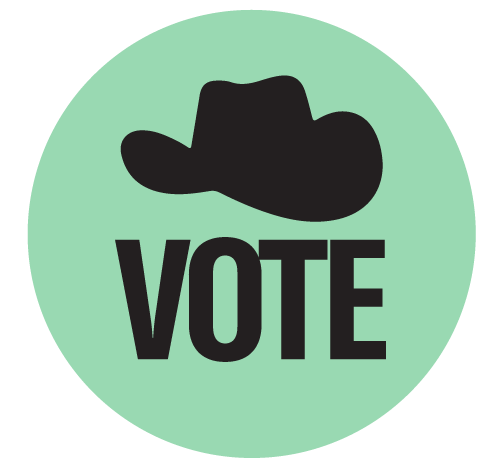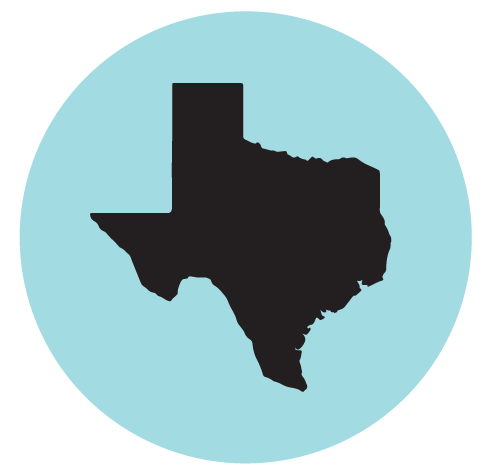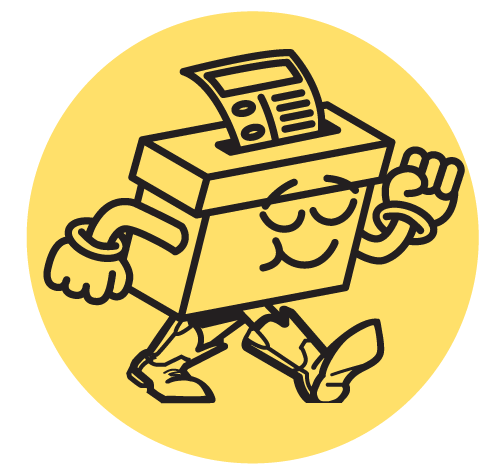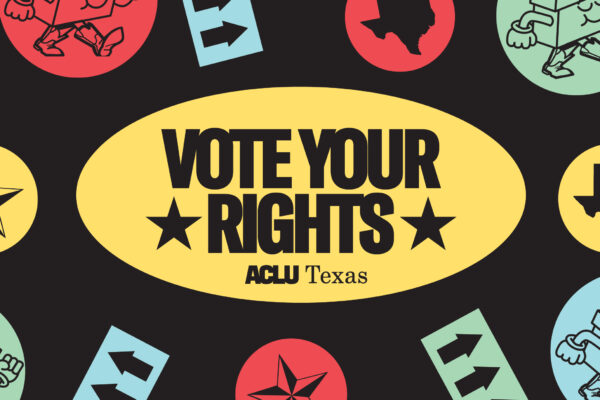Be a Texas voter this election.
By being a voter, you can demand that elected officials take bold action to protect your rights. As politicians attack our free speech, reproductive freedom, and other civil liberties, we can show them that we the people have the final say.
Our ancestors dreamed of a better life for their families and communities. Let’s continue their legacy by making our voices heard at the polls.
Are you ready to vote for your rights?
Register to vote | Make a plan | Grab your ID | Vote your rights

1. Register to vote
Check your voter registration to make sure you’re registered to vote. The deadline to register to vote in the upcoming election is February 2, 2026.
Learn more:
Need help?
Contact your county clerk or elections administrator. Beginning October 1, you can also reach out to the Election Protection Hotline (1-866-OUR-VOTE or 1-888-VE-Y-VOTA).
Top | Continue to the next step ↓

2. Make a plan
Vote early from February 17, 2026 to February 27, 2026.
Election Day is March 3, 2026 from 7 a.m. to 7 p.m.
Find the location of your polling place and make a plan to get there:
- If your county has county-wide polling, you can go anywhere in your county to vote.
- If your county does not have county-wide polling:
- You can vote anywhere in the county during early voting.
- You can only vote at your designated polling location on Election Day.
Learn what’s on your ballot and how you can protect our future by being a voter.
Vote by mail
Apply for a mail ballot for the upcoming election by February 20, 2026.
You are eligible to vote by mail if:
- You are sick or have a disability.
- If you are expected to give birth three weeks before or after election day.
- You are 65 years or older.
- You are confined in jail, but otherwise eligible to vote.
- You will be out of the county on Election Day and during the period for early voting.
Get more information about voting by mail and important deadlines for the upcoming election.
Learn more:
Need help?
Contact your county clerk or elections administrator. Beginning October 1, you can also reach out to the Election Protection Hotline (1-866-OUR-VOTE or 1-888-VE-Y-VOTA).
Top | Continue to the next step ↓

3. Grab your ID
Texas requires a valid ID to vote. The following are acceptable forms of identification:
- Texas driver license
- Election identification certificate from the Texas Department of Public Safety
- Personal identification card from the Texas Department of Public Safety
- U.S. military ID card with your photo
- U.S. citizenship certificate with your photo
- U.S. passport
- License to carry a concealed handgun from the Texas Department of Public Safety
If you’re a registered voter, you may still be able to cast a ballot if you don’t have or no longer have an accepted form of ID. Learn how.
You do not have to bring your voter registration card to vote.
Learn more:
- My identification is expired
- My identification lists an old address
- The gender marker on my identification is outdated
- I don’t have the right kind of identification
Need help?
Contact your county clerk or elections administrator. Beginning October 1, you can also reach out to the Election Protection Hotline (1-866-OUR-VOTE or 1-888-VE-Y-VOTA).
Top | Continue to the next step ↓

4. Vote your rights
This upcoming election, our rights are on the ballot. Your vote matters.
Keep these things in mind as you head to the polls:
- You can’t wear any clothing or items with the names of candidates, political parties, or ballot measures that will be on the ballot.
- Actively campaigning or trying to influence individuals’ votes – or “electioneering” – is prohibited within 100 feet of the polling stations. There will be signs clearly marking the 100-foot point.
- Using cell phones or other tech is also prohibited within 100 feet of the voting stations. This includes taking photos or videos. Keep phones turned off and in your pockets once you are inside the 100-foot boundary.
- You can bring written or printed notes with you into the booth.
- If you make a mistake on your ballot, ask for a new one.
- If the machines are down at your polling place, ask for a paper ballot.
- If you are in line at the time that the polls close, stay in line.
Learn what’s on your ballot and how you can protect our future by being a voter.
Learn more:
- I registered to vote, but the poll worker says I'm not on the list of registered voters
- Someone is interfering with my right to vote
Need help?
If you run into any problems or have questions while voting, call or text the Election Protection Hotline:
- English: 1-866-OUR-VOTE / 1-866-687-8683
- Spanish: 1-888-VE-Y-VOTA / 1-888-839-8682
- Voters with Disabilities: 602-274-6287
- Native Voters: 888-777-3831
- Asian Languages: 888-API-VOTE / 888-274-8683
- Arabic: 1-844-YALLA-US / 1-844-925-5287
Top | Take action ↓
Know Your Rights
You are eligible to vote if:
- You are a United States citizen.
- You are a resident of the State and of the county where you are trying to vote.
- You are 18 years old (you can register to vote if you are at least 17 years and 10 months old and will be 18 on Election Day).
- You registered before the deadline — 30 days before an election in Texas.
- If you have been finally convicted of a felony, you have completed your sentence, including any term of incarceration, parole, supervision, or probation.
- You have not been declared by a court exercising probate jurisdiction to be either totally mentally incapacitated or partially mentally incapacitated without the right to vote.
I have moved or changed my name
- You can update your information when you renew your driver’s license or with the Texas Secretary of State.
- You can also notify the county voter registrar in writing by:
- Updating your address on the back of your current voter registration certificate
- Filling out a new voter registration application form and checking the “change” box
- You can also notify the county voter registrar in writing by:
- If you move within the county:
- If your county has county-wide voting, you can still vote at any location in your county. A list of counties with county-wide polling is available on the Texas Secretary of State's website.
- If your county does not have county-wide voting, you must vote in your precinct:
- You will be able to vote in your new precinct 30 days after you submit your address change.
- If you do not change your address 30 days before the election, you can vote in your former precinct.
- When you go to vote, inform the election workers that your address has changed and needs to be updated before you vote.
- If you moved to a new county:
- You must update your voter registration.
- Voters who moved outside of the county where they’re registered to vote and did not update their registration in time can still vote in statewide races using a limited ballot. They can only cast a limited ballot during the early voting period and at the main early voting polling place. Voters eligible to vote by mail can also request a limited ballot by mail.
You are eligible to vote by mail if:
- You are sick or have a disability.
- If you are expected to give birth three weeks before or after election day.
- You are 65 years or older.
- You are confined in jail, but otherwise eligible to vote.
- You will be out of the county on election day and during the period for early voting.
Your application and ballot will ask for a driver's license or Social Security number. We strongly encourage you to include both numbers.
Your application must be received by the County Clerk by February 20, 2026.
Your ballot will then be mailed to you and must subsequently be received by the County Clerk by —
- March 3, 2026 (Election Day) at 7 p.m. if the carrier envelope is NOT postmarked.
- March 4, 2026 (next business day after Election Day) at 5:00 p.m. if the carrier envelope is postmarked by 7 p.m. at the location of the election on Election Day.
If there is an error on your mail-in ballot:
- You can correct ID number errors on your application or ballot, and track the status of your application or ballot, by using the Texas Secretary of State website.
- If the elections office mails you your voted ballot back with an error notice, you can correct your ballot and return it to your local elections office by 7 p.m. on Election Day. You also have the option to vote in person through Election Day; if you don’t bring your ballot, you will need to vote a provisional ballot.
- If your ballot is rejected without being returned to you, you have six days after the election to “cure” or fix the problem by appearing in person at your county elections office.
I need accommodations for my disability or limited English proficiency
Know your rights:
- Under federal law, all polling places for federal elections must be accessible to disabled and elderly voters or must provide alternate means for casting a ballot on the day of the election.
- If a voter is physically unable to enter the polling place, they may vote curbside by asking that an election officer bring a ballot to the entrance of the polling place or to a car parked at the curbside.
- Under federal law, all voters who require assistance because of limited English proficiency or a disability may obtain assistance in voting from a person of their choice, as long as this person is not the voter’s employer or an agent of the employer or of the voter’s union.
- In some places (those covered by Section 203 of the Voting Rights Act), trained bilingual poll workers must be available to provide assistance in the relevant language, and ballots, written forms, and information relating to the voting process must be available in the covered language.
- All polling places for a federal election must have at least one voting system that makes voting accessible in a private and independent manner to voters with disabilities.
- Voters with disabilities cannot be turned away from the polls because a poll worker thinks they do not have the capacity to vote.
What can you do?
- If possible, bring a family member, friend, or another person of your choice to assist you at the polls. Don’t bring your employer or an agent of your employer or union.
- Tell the poll workers that you have chosen this person to assist you with voting. The person assisting you will be required to take an oath and fill out a form disclosing their relationship to you, and confirming that they are not being compensated for providing assistance.
- If you do not have an assistant, you may request assistance from a poll worker. Although all Texas counties must provide Spanish language materials, only some counties must provide Spanish language interpreters. Some counties provide interpretation services for other languages. You should check with your County first if you intend to rely on a poll worker for language assistance.
Voters under 70 years old can use a valid photo ID that has been expired up to four years. Voters aged 70 and older can use a valid photo ID that has been expired for any length of time.
My identification lists an old address
You can still vote as long as you are registered to vote at your current address, or update your voter registration to reflect your new address.
The name, gender marker, or photo on my identification is outdated.
State law only requires that the name on your ID be “substantially similar” to the name on your voter registration. Names may be substantially similar if they are:
• Only “slightly different”
• Common nicknames
• Missing or have in a different place an initial, a middle name, or a former name.
If the reviewing election worker makes a determination that your name on the presented ID document and your voter registration are substantially similar, you will be asked to fill out a “Similar Name” form stating that you are the same person on the list of registered voters.
If an election worker cannot match the name on your identification to the list of registered voters, or if the election worker cannot verify your identity based on your presented identification, you are still eligible to cast a provisional ballot. For a provisional ballot to be counted in this situation, you will have to visit your county voter registrar’s office and present acceptable identification within six calendar days.
I don’t have the right kind of identification
You may still be able to vote. Here's how:
- If you do not possess an acceptable ID and have a reasonable impediment to possessing an ID, tell the poll worker you want to complete a “reasonable impediment declaration.” This simple document lets you explain the difficulty that prevented you from getting a photo ID. Reasonable impediments to getting a photo ID include work schedule, lack of transportation, disability or illness, family responsibilities, lost or stolen identification, lack of documents needed to obtain a photo ID, and photo ID applied for but not received.
- Fill out the form and present it to the poll worker. Poll workers can’t question or challenge you about not having a photo ID, or the reason you give on your “reasonable impediments declaration.”
- Show one of the following documents:
- Current utility bill
- Bank statement
- Paycheck
- Voter Registration Certificate
- Certified birth certificate
- Government check
- A government document that shows the voter's name and an address
I registered to vote, but the poll worker says I'm not on the list of registered voters
Know your rights:
- All eligible voters are entitled to a provisional ballot if they believe they are registered, even if they are not in the poll book. If you believe you are eligible and registered to vote where you are, you can request a provisional ballot.
- After Election Day, election officials must investigate whether you are qualified to vote and registered; if you are, they must count your provisional ballot.
What can you do?
- Ask the poll worker to double-check for your name on the list of registered voters.
- If your name isn’t there, ask if there is a supplemental list of voters (sometimes, voters who register closer to Election Day are placed on a supplemental list of registered voters).
- You may also request that the poll workers check a statewide system, if one is available, to see if you are registered to vote at a different polling place.
- If they still can’t find your name, and you believe you are eligible to vote and in the right place, ask for a provisional ballot.
- If you are turned away or denied a provisional ballot, you can call the Election Protection Hotline (1-866-OUR-VOTE or 1-888-VE-Y-VOTA).
Someone is interfering with my right to vote
The following are examples of voter intimidation:
- Aggressively questioning voters about their citizenship, criminal record, or other qualifications to vote, in a manner intended to interfere with the voters’ rights.
- Falsely representing oneself as an elections official.
- Spreading false information about voter requirements, such as falsely claiming that voters must be able to: speak English, vote without an assistant, or present a voter registration card.
- Displaying false or misleading signs about voter fraud and related criminal penalties
- Other forms of harassment, particularly harassment targeting non-English speakers and voters of color, including by poll watchers.
What should you do if you experience voter intimidation?
- You can report intimidation to the Election Protection Hotline by calling 1-866-OUR-VOTE or 1-888-VE-Y-VOTA (en español).
- You can also contact the U.S. Department of Justice Voting Rights Hotline: 800-253-3931; TTY line 877-267-8971
- Reach out to local and state officials, including poll workers, your county clerk, elections administrator, or county voter registrar.
This content is intended to serve as general information; it is not legal advice nor intended as legal advice.
Stay Informed
Sign up to be the first to hear about how to take action.
By completing this form, I agree to receive occasional emails per the terms of the ACLU’s privacy statement.
By completing this form, I agree to receive occasional emails per the terms of the ACLU’s privacy statement.


